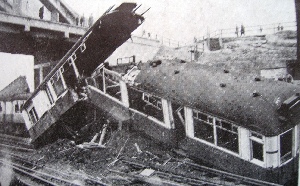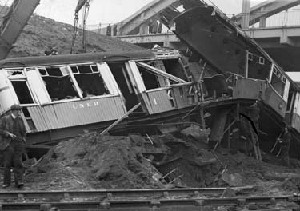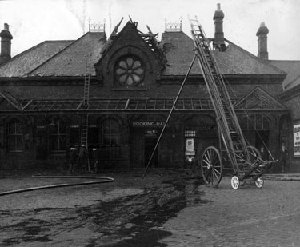
Bombing of South Shields April 1941

Bombed Rolling Stock April 1941

South Shields Station Bomb Damage
There were six men on duty that night. Yard Inspector R. Hume, Driver J. Steel, Shunter J. Angus, Yard Inspector D. Colthorpe, Guard R. S. Ward, and Asst. Traffic Agent G. Brown. The first two received the George Medal, and the remaining four received the British Empire Medal.
Driver Steel hooked the engine on to the burning wagons and drew them for some distance down the yard, until he reached a water column. Each wagon in turn was pulled up to the column, and is fire put out. These men worked from 1am to 6am with bombs falling round them all the time. They saved most of the shipment, and the vessel lying at the dock was able to continue loading next morning as usual. Whilst all this was going on signalman Clark stuck to his post at Tyne Dock Bottom all through the night.
Also South Shields station was badly bombed one night, and at the time there was only three men on duty at the time. One of them Signalman Thompson, related how a bomb hit an electric train in the yard, and blew one coach in half. The same bomb blew him down the steps of the Signal-box. A little later he climbed up on the roof of the station with an axe, in order to remove an incendiary bomb, which had fallen inside the Station clock. A hose and stirrup pump were available, but all the water in the mains was being pumped by the N.F.S. (National Fire Service) on to a neighbouring cinema [Queens Cinema]. He tried and tried to get the bomb out of the clock, and gave up only when molten lead began to run on to his coat sleeve. Then he climbed down into the road and collected a passing fire escape. Still no water. As a last resort they got a pump down to the river, but by this time the station was well ablaze.
Later he went back to his signal-box. All the windows were out, gas mains were leaking, and the whole place was filthy. When the District Superintendent turned up, he found Thompson looking absolutely black. He was sent home for a rest."
Source: The LNER in wartime By rail to Victory by Norman Crump. Published by the LNER 1947. Printed by Jarrold and Sons Ltd. Norwich.

